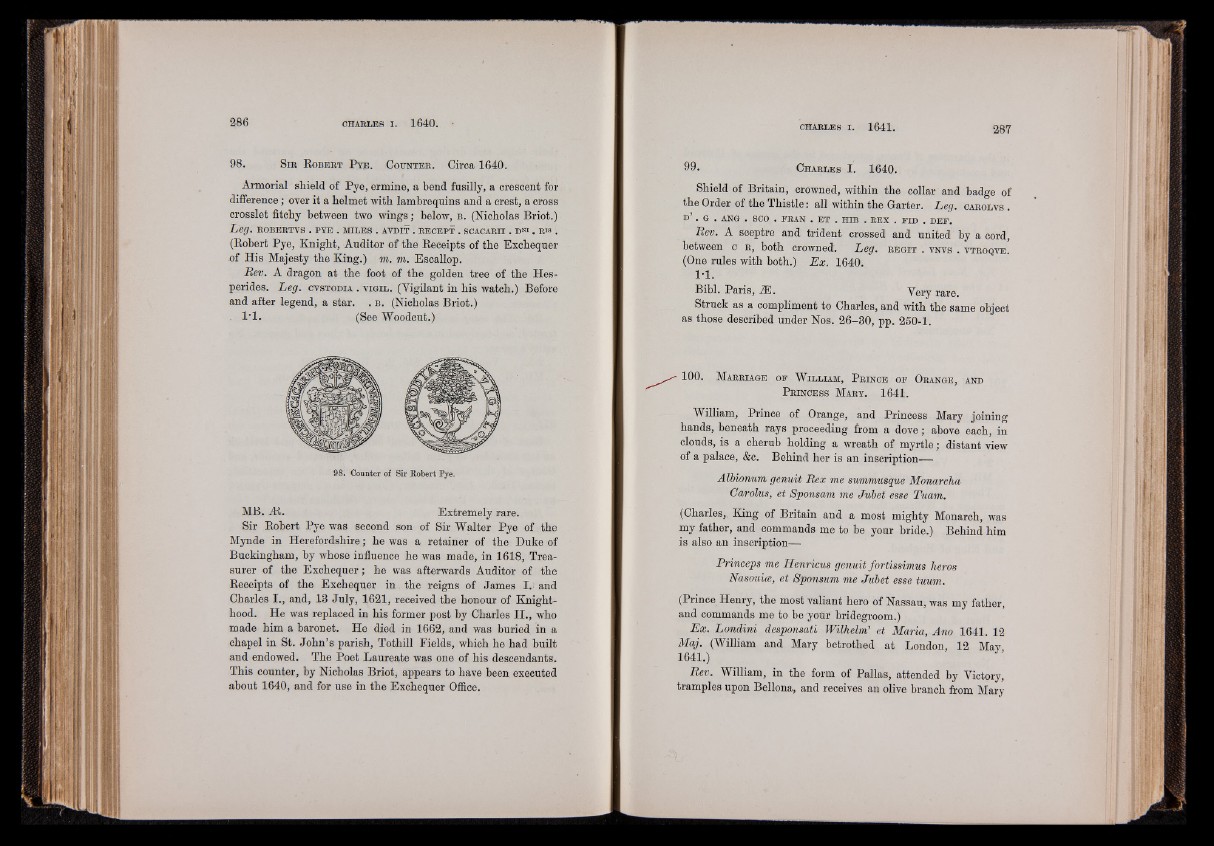
98. S i r R o b e r t P y e . C o u n t e r . Circa 1640.
Armorial shield of Pye, ermine, a bend fusilly, a crescent for
difference ; over it a helmet with lambrequins and a crest, a cross
crosslet fitchy between two wings ; below, b . (Nicholas Briot.)
Leg. ROBERTVS . PYE . MILES . AVDIT . RECEPT . SCACARII . DNI • RIa .
(Robert Pye, Knight, Auditor of the Receipts of the Exchequer
of His Majesty the King.) m. m. Escallop.
Rev. A dragon at the foot of the golden tree of the Hes-
perides. Leg. c v s t o d i a . v i g i l . (Vigilant in his watch.) Before
and after legend, a star. . b . (Nicholas Briot.)
l ’l . (See Woodcut.)
MB. At. Extremely rare.
Sir Robert Pye was second son of Sir Walter Pye of the
Mynde in Herefordshire; he was a retainer of the Duke of
Buckingham, by whose influence he was made, in 1618, Treasurer
of the Exchequer; he was afterwards Auditor of the
Receipts of the Exchequer in the reigns of James I. and
Charles I., and, 13 July, 1621, received the honour of Knighthood.
He was replaced in his former post by Charles II., who
made him a baronet. He died in 1662, and was buried in a
chapel in St. John’s parish, Tothill Fields, which he had built
and endowed. The Poet Laureate was one of his descendants.
This counter, by Nicholas Briot, appears to have been executed
about 1640, and for use in the Exchequer Office.
9 9 . C h a r l e s I. 1640.
Shield of Britain, crowned, within the collar and badge of
the Order of the Thistle: all within the Garter. Leg. c a r o l v s .
d ’ . G . ANG . SCO . FRAN . ET . HIB . REX . FID . DEF.
Rev. A sceptre and trident crossed and united by a cord,
between o r , both crowned. Leg. r e g i t . v n v s . v t r o q v e .
(One rules with both.) Ex. 1640.
1-1.
Bibl. Paris, 2E. Very rare.
Struck as a compliment to Charles, and with the same object
as those described under Nos. 26-80, pp. 250-1.
100. M a r r i a g e o f W i l l i a m , P r i n c e o f O r a n g e , a n d
P r i n c e s s M a r y . 1641.
William, Prince of Orange, and Princess Mary joining
hands, beneath rays proceeding from a dove; above each, in
clouds, is a cherub holding a wreath of myrtle; distant view
of a palace, &c. Behind her is an inscription—
Albionum genuit Rex me summusque Monarcha
Carolus, et Sponsam me Jubet esse Tuam.
(Charles,, King of Britain and a most mighty Monarch, was
my father, and commands me to be your bride.) Behind him
is also an inscription—
Princeps me Henricus genuit fortissimus heros
Nasouia, et Sponsum me Jubet esse tuum.
(Prince Henry, the most valiant hero of Nassau, was my father,
and commands me to be your bridegroom.)
Ex. Londini desponsati Wilhelm,' et Maria, Ano 1641. 12
Mag. (William and Mary betrothed at London, 12 May
1641.)
Rev. William, in the form of Pallas, attended by Victory,
tramples upon Bellona, and receives an olive branch from Mary